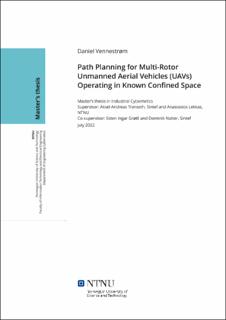| dc.contributor.advisor | Transeth, Aksel A. | |
| dc.contributor.advisor | Grøtli, Esten I. | |
| dc.contributor.advisor | Natter, Dominik | |
| dc.contributor.advisor | Lekkas, Anastasios | |
| dc.contributor.author | Vennestrøm, Daniel | |
| dc.date.accessioned | 2022-11-18T18:19:32Z | |
| dc.date.available | 2022-11-18T18:19:32Z | |
| dc.date.issued | 2022 | |
| dc.identifier | no.ntnu:inspera:102231297:33106797 | |
| dc.identifier.uri | https://hdl.handle.net/11250/3032963 | |
| dc.description.abstract | Denne masteroppgaven anser et bruksområde hvor en multi-rotor inspeksjons dronen autonomt skal inspisere et sett med punkter inne i en ballast tank på et skip. For å oppnå dette, så er et av de første stegene å implementere en baneplanlegger som yter bra i et slikt scenario. Denne masteroppgaven undersøker gjennom litteratur søk og testing av ulike bane planleggere; hva som konstituerer en baneplanlegger som fungerer bra for multi-rotor droner i kjente trange rom.
Gjennom arbeidet som ble gjennomført ble det klart at baneplanlegger for 3D applikasjoner er mange og ustrukturerte. Bruksområdet er relativt lite utforsket i litteraturen og tilgengeligheten for 3D baneplanleggere som planleger til eksakte "poses" er dårlig. Det finnes i tillegg relativt få allmenn tilgjengelig komplette pakker som er oppdatert og klar for implementeres gjennom ROS-melodic.
Baneplanleggerne som ble tested var GBplanner og Voxblox RRT planner. GBplanner oppnådde ikke den eksakte posisjonen som ble forespurt, dette var fordi den globale grafen ikke inkluderte ethvert vilkår punkt som ble etterspurt. Til sammenligning så var Voxblox RRT planner betydelig tregere, men dersom den lykkes så var posisjonen eksakt. Problemet med Voxblox var at banen som ble generert ikke er optimal i forhold til banen generert gjennom Dijkstra's søke algoritme anvendt på den globale grafen til GBplanner. | |
| dc.description.abstract | This master's thesis considers an use case where an Unmanned Aerial Vehicle (UAV) is going to autonomously investigating some point of interest (POIs) within a ballast tank onboard a ship. This requires a suitable path planner which performs well in the described scenario to be implemented. Through research and testing of various path planners this thesis aims to describe what constitutes a path planner that functions well for UAV in known confined space. The thesis only considers part of the use case, such that the focus is going to be on planning a path in known confined space and challenges related to this. \\
\\
Throughout the work performed in this thesis it has been made clear that not all path planners for 3D applications are suitable for the use case at hand. The application area described in the use case above is not explored a lot in the available literature. Additionally, there is not a lot of available "complete" package which are up to data and can easily be implemented through ROS-melodic. This limits the approach of finding a pre-made path planner, which will work for the specific use case. \\
\\
The path planners tested were GBplanner and Voxblox RRT planner. GBplanner did not achieve accuracy due to the global graph not including the goal pose. While the Voxblox RRT Planner was slow, but it usually managed to generate a path to the exact position. The final conclusion is that it is important to balance the different aspect of a path planning approach so that it fits the use case. | |
| dc.language | eng | |
| dc.publisher | NTNU | |
| dc.title | Path Planning for Multi-Rotor Unmanned Aerial Vehicles (UAVs) Operating in Known Confined Space | |
| dc.type | Master thesis | |
